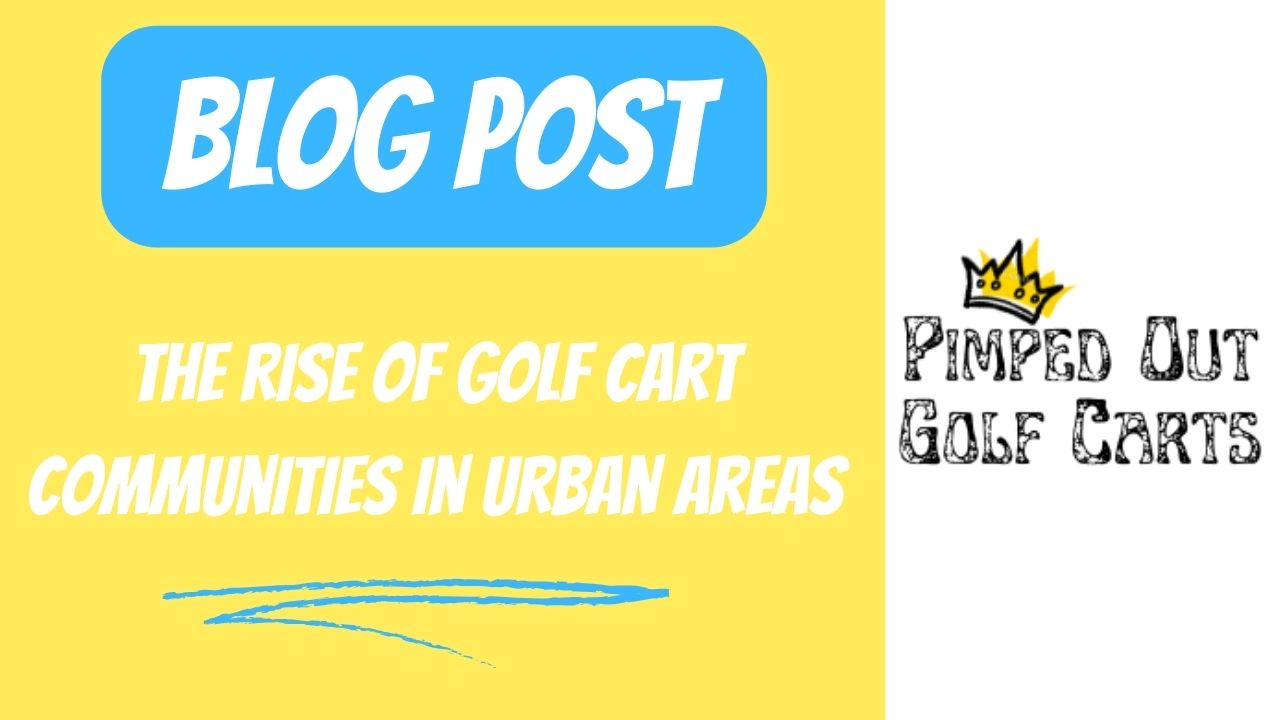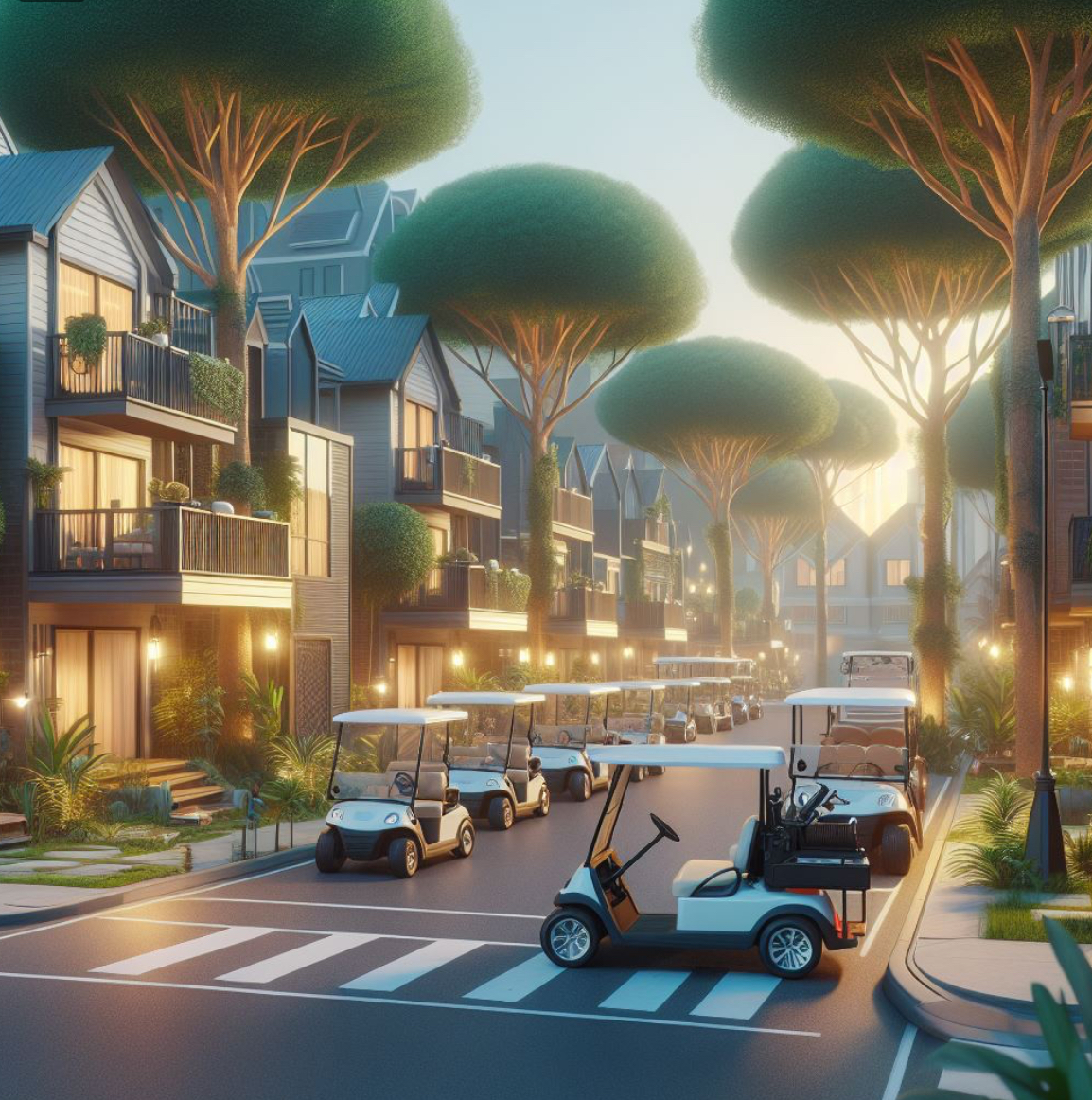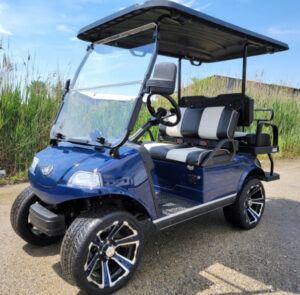
In recent years, a fascinating trend has emerged in urban planning and lifestyle choices: the rise of golf cart communities in urban areas. Once reserved for sprawling golf courses and retirement communities, golf carts are now becoming a staple mode of transportation in cities around the world. This shift represents not only a change in how we navigate our urban environments but also a significant step towards sustainable living.
The concept of a golf cart community may sound novel at first, but its appeal is rooted in practicality and environmental consciousness. As urban areas continue to grapple with issues like traffic congestion, air pollution, and limited green space, the adoption of golf carts offers a promising solution. By embracing this alternative mode of transportation, residents are not only reducing their carbon footprint but also reimagining the way we interact with our cities.
Additionally, there are various facets to the rise of golf cart communities in urban areas. From the environmental impact to the economic considerations and the lifestyle benefits, we will explore why more and more cities are embracing this innovative approach to urban living. Furthermore, we will examine the challenges and opportunities that come with integrating golf carts into city planning and design.
So, come discover how golf cart communities are reshaping the urban landscape and paving the way for a more sustainable, connected, and vibrant future. Whether you’re a city dweller curious about this emerging trend or an urban planner seeking inspiration for your next project, there’s much to learn and explore in the world of golf cart-centric living.
The Environmental Impact Of Golf Cart Communities In Urban Areas
In an era defined by pressing environmental concerns, the emergence of golf cart communities in urban areas offers a beacon of hope for sustainable living. Unlike traditional gas-powered vehicles, golf carts produce zero tailpipe emissions, making them a cleaner and greener mode of transportation. This shift towards electric-powered mobility represents a crucial step in mitigating the adverse effects of carbon emissions on our planet.
According to studies, the average passenger vehicle emits approximately 4.6 metric tons of carbon dioxide per year. In contrast, electric golf carts produce no direct emissions, operating solely on battery power. This significant reduction in greenhouse gas emissions not only improves air quality but also contributes to global efforts to combat climate change.
Moreover, the compact size and lightweight design of golf carts make them inherently more energy-efficient than conventional vehicles. With lower energy consumption and minimal maintenance requirements, golf carts offer a sustainable alternative for short-distance travel within urban environments. Whether navigating narrow city streets or cruising through pedestrian-friendly neighborhoods, golf cart communities exemplify the principles of smart, eco-conscious urban planning.
Beyond emissions reduction, the adoption of golf carts in urban areas can also lead to a decrease in noise pollution. Compared to the roar of engines and honking horns typical of urban traffic, golf carts operate quietly, preserving the tranquility of residential neighborhoods and enhancing the overall quality of life for residents.
Furthermore, the environmental benefits of golf cart communities extend beyond transportation. By promoting walkability and reducing reliance on cars, these communities encourage residents to embrace more sustainable lifestyle choices. With amenities like community gardens, green spaces, and pedestrian-friendly pathways, golf cart-centric neighborhoods foster a deeper connection to nature and promote a culture of environmental stewardship.
In essence, the rise of golf cart communities in urban areas represents a paradigm shift towards more sustainable, environmentally-friendly modes of living. By harnessing the power of clean energy and reimagining urban mobility, these communities are not only reducing their ecological footprint but also setting a positive example for cities worldwide. As we continue to confront the challenges of climate change and urbanization, the importance of initiatives like golf cart communities cannot be overstated in shaping a healthier, more sustainable future for generations to come.
Urban Planning And Design
The integration of golf cart communities into urban planning and design represents a bold departure from traditional approaches to city development. As cities grapple with the dual challenges of population growth and environmental sustainability, the adoption of golf carts offers a refreshing perspective on how we envision and shape our urban environments.
One of the key elements of golf cart-friendly urban planning is the design of infrastructure that accommodates alternative modes of transportation. From dedicated golf cart lanes to charging stations strategically located throughout the city, urban planners are reimagining the layout of streets and neighborhoods to facilitate the seamless integration of golf carts into everyday life.
In addition to enhancing mobility, golf cart-friendly urban planning prioritizes accessibility and connectivity. By creating pedestrian-friendly pathways and mixed-use developments, cities can reduce reliance on cars and promote a more vibrant, community-oriented urban landscape. This approach not only fosters social interaction and active living but also supports local businesses and cultural institutions.
Furthermore, the design of golf cart communities emphasizes sustainability and environmental stewardship. From green roofs and rain gardens to solar-powered streetlights and water-saving landscaping, these communities prioritize eco-friendly practices that minimize their ecological footprint. By incorporating sustainable design principles into every aspect of urban planning, cities can create more resilient and livable environments for residents.
Moreover, the rise of golf cart communities presents an opportunity to rethink zoning regulations and land use policies. By incentivizing developers to incorporate golf cart infrastructure into new projects and retrofitting existing neighborhoods to accommodate alternative modes of transportation, cities can promote a more diverse and inclusive urban landscape.
Ultimately, golf cart-friendly urban planning is about more than just transportation—it’s about reimagining the way we live, work, and play in our cities. By prioritizing sustainability, connectivity, and community, cities can create vibrant, resilient urban environments that enhance quality of life for all residents. As we continue to confront the challenges of urbanization and climate change, the principles of golf cart-centric urban planning offer a blueprint for building cities that are not only environmentally sustainable but also socially inclusive and economically vibrant.

Lifestyle And Convenience
The appeal of golf cart communities extends far beyond their environmental benefits and urban planning innovations. At the heart of this emerging trend lies a lifestyle centered around convenience, connectivity, and community.
One of the primary draws of golf cart living is the unparalleled convenience it offers residents. With golf carts serving as the primary mode of transportation, commuting becomes a breeze, eliminating the hassle of navigating congested streets and searching for parking. Whether running errands, commuting to work, or simply exploring the neighborhood, residents can enjoy an stress-free and efficient travel experience.
Moreover, the compact size and maneuverability of golf carts make them ideal for navigating tight urban spaces and accessing hard-to-reach destinations. From bustling city centers to quiet residential streets, golf cart communities provide residents with unparalleled flexibility and freedom to explore their surroundings at their own pace.
Beyond transportation, golf cart communities foster a sense of connection and camaraderie among residents. With shared amenities like community pools, parks, and recreational facilities, residents have ample opportunities to socialize and engage in leisure activities with their neighbors. Whether participating in neighborhood events, organizing impromptu golf cart parades, or simply exchanging friendly waves while out for a ride, golf cart living cultivates a strong sense of community spirit and belonging.
Additionally, the lifestyle afforded by golf cart communities promotes an active and healthy way of life. With pedestrian-friendly streets and ample green spaces, residents are encouraged to embrace outdoor activities like walking, biking, and jogging. Whether enjoying a leisurely stroll through the neighborhood or embarking on a scenic golf cart ride through local parks, residents have countless opportunities to stay active and enjoy the natural beauty of their surroundings.
Furthermore, the convenience of golf cart living extends beyond transportation to encompass everyday tasks and errands. From grocery shopping and dining out to visiting local shops and businesses, residents can easily access all the amenities and services they need without ever having to leave the comfort of their neighborhood.
In essence, golf cart communities offer a lifestyle that is as practical as it is enjoyable.
With their emphasis on convenience, connectivity, and community, these neighborhoods provide residents with a unique opportunity to live in harmony with their environment while enjoying the countless benefits of urban living. As the popularity of golf cart communities continues to grow, so too does the opportunity to experience the unparalleled lifestyle they offer.
Economic Considerations
The rise of golf cart communities in urban areas is not only reshaping the way we live and move but also presenting compelling economic opportunities for residents and cities alike. From cost savings and property values to job creation and economic growth, the economic considerations associated with golf cart living are as diverse as they are impactful.
One of the most immediate economic benefits of golf cart communities is the potential for significant cost savings for residents. Compared to traditional vehicles, golf carts are more energy-efficient and require minimal maintenance, resulting in lower operating costs over time. With no need for gas, oil changes, or expensive repairs, residents can enjoy considerable savings on transportation expenses, freeing up more resources for other priorities.
Moreover, the adoption of golf carts in urban areas can have a positive impact on property values. Studies have shown that homes located in golf cart communities often command higher prices and experience faster appreciation compared to similar properties in non-golf cart neighborhoods. The convenience, lifestyle amenities, and eco-friendly appeal of these communities make them highly desirable for homebuyers seeking a modern, sustainable way of life.
Furthermore, the emergence of golf cart communities can spur economic development and job creation in urban areas. From the construction of new infrastructure and amenities to the establishment of golf cart rental services and local businesses catering to residents’ needs, the growth of golf cart-centric living creates opportunities for entrepreneurs and workers across various sectors.
Additionally, cities stand to benefit economically from the adoption of golf carts as part of their urban transportation strategy. By reducing traffic congestion and emissions, golf carts help alleviate strain on existing infrastructure and public services, resulting in potential cost savings for municipalities. Moreover, the creation of golf cart-friendly zoning regulations and incentives for developers can attract investment and stimulate economic activity in urban areas.
Overall, the economic considerations associated with golf cart communities underscore the multifaceted benefits of this emerging trend. From individual cost savings and property value appreciation to broader economic development and sustainability goals, golf cart-centric living offers a compelling case for cities and residents alike. As cities continue to explore innovative solutions for urban mobility and sustainability, the economic potential of golf cart communities remains a promising avenue for growth and prosperity.
Challenges And Solutions
While the rise of golf cart communities in urban areas presents numerous benefits, it also comes with its fair share of challenges. From safety concerns to regulatory hurdles, addressing these challenges is essential to ensuring the successful integration of golf carts into urban environments. Fortunately, innovative solutions and collaborative efforts are underway to overcome these obstacles and pave the way for a more sustainable and connected future.
One of the primary challenges associated with golf cart communities is ensuring the safety of residents and pedestrians. Unlike traditional vehicles, golf carts lack certain safety features such as seat belts and airbags, raising concerns about potential accidents and injuries. To mitigate these risks, cities must invest in infrastructure improvements such as designated golf cart lanes, traffic-calming measures, and enhanced signage to ensure safe and efficient travel for all road users.
Moreover, educating residents about safe driving practices and the rules of the road is crucial for promoting responsible golf cart usage. From obeying speed limits and yielding to pedestrians to avoiding distracted driving, fostering a culture of safety among residents is essential for preventing accidents and promoting harmony in golf cart communities.
Another challenge facing golf cart communities is navigating regulatory frameworks and zoning regulations. Many cities lack specific guidelines for golf cart usage on public roads, leading to confusion and inconsistency in enforcement. To address this issue, cities can work with local governments, community stakeholders, and transportation agencies to develop clear and comprehensive regulations that prioritize safety while accommodating the unique needs of golf cart users.
Furthermore, integrating golf cart infrastructure into existing urban environments requires careful planning and coordination among various stakeholders. From retrofitting streets and sidewalks to installing charging stations and amenities, cities must invest in infrastructure upgrades to support the growing demand for golf cart transportation. By incorporating golf cart-friendly design principles into urban planning initiatives, cities can create a more inclusive and accessible built environment for residents of all ages and abilities.
Additionally, addressing concerns about accessibility and equity is essential for ensuring that golf cart communities benefit all residents, not just a privileged few. Cities must prioritize equitable access to golf cart infrastructure and amenities, particularly in underserved communities where access to transportation options may be limited. By engaging with community members and incorporating their feedback into planning and decision-making processes, cities can ensure that golf cart communities are inclusive, diverse, and accessible to all.
Notably, while the rise of golf cart communities in urban areas presents its fair share of challenges, innovative solutions and collaborative efforts are underway to address these obstacles and unlock the full potential of this emerging trend. By prioritizing safety, regulatory clarity, infrastructure investment, and equitable access, cities can pave the way for a more sustainable, connected, and vibrant future powered by golf cart-centric living.
Conclusion
As we reach the end of our exploration into the rise of golf cart communities in urban areas, it’s clear that this emerging trend represents far more than just a novel mode of transportation—it’s a transformative shift towards a more sustainable, connected, and vibrant way of life.
From the environmental benefits of reducing carbon emissions to the economic opportunities for cost savings and property value appreciation, the advantages of golf cart-centric living are undeniable. By prioritizing convenience, connectivity, and community, these communities offer residents a lifestyle that is as practical as it is enjoyable.
Moreover, the challenges associated with integrating golf carts into urban environments—from safety concerns to regulatory hurdles—underscore the importance of proactive planning and collaborative solutions. By investing in infrastructure improvements, developing clear and comprehensive regulations, and promoting equity and accessibility, cities can ensure that golf cart communities thrive and benefit all residents.
Looking ahead, the future of golf cart living is bright. As cities continue to grapple with the complex challenges of urbanization, climate change, and equity, the principles of golf cart-centric living offer a roadmap for building more resilient, sustainable, and inclusive communities. By embracing innovation, collaboration, and a shared vision for the future, we can create cities that not only meet the needs of today but also pave the way for a better tomorrow.
In closing, the rise of golf cart communities in urban areas represents a remarkable opportunity to reimagine the way we live, move, and interact in our cities. Whether you’re a resident exploring the benefits of golf cart living or a city planner seeking inspiration for your next project, the potential of golf cart-centric living is boundless. Together, let’s embrace this exciting journey towards a more sustainable, connected, and vibrant future for all.
 Happy Carting!
Happy Carting!
Shop Golf Carts

